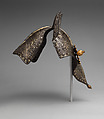Returned to lender The Met accepts temporary loans of art both for short-term exhibitions and for long-term display in its galleries.
Half-Shaffron for an Armor of King Philip IV of Spain (1605–1665) or his Brother Don Carlos (1607–1632)
Attributed to Pierre du Coudroy French
Attributed to François Le Gras Flemish
Not on view
This half-shaffron (headpiece for a horse) is exceptional for its original and masterful shape and ornamentation. It belongs to one of four luxury armors that King Philip IV of Spain (r. 1621–65) commissioned in 1624 for himself and his younger brother Don Carlos (1607–1632). This request seems to have been motivated by two armors that the Brussels armorer Pierre du Coudroy had couriered from the southern Netherlands and personally delivered to the king in Spain. Sent by Philip IV’s aunt, Isabella Clara Eugenia of Austria (1566–1633), who was governing the southern Netherlands on the king's behalf, the two armors were perhaps a gift from her to him, and meant for his personal use, as has traditionally been assumed. Alternatively, they may have been heirlooms from her late husband, Archduke Albert VII of Austria (1559–1621), sent to Spain to be deposited in the royal armory of Madrid, alongside the armors of other illustrious members of the House of Habsburg. Whatever the reasons for sending them to Spain, it is clear enough that the two armor brought to Philip made a strong impression on him. Following their reception the king granted du Coudroy a yearly pension, a Spanish horse to return home, and a sum of money to undertake the manufacture of four more armors. Du Coudroy journeyed back to Brussels with clothes belonging to the king and his brother, from which he could derive the basic measurements for the requested armors
The four armors that Philip IV commissioned from du Coudroy consisted of two cavalry and two infantry armors, which were completed and delivered in 1626. Although it seems likely that Philip and his brother each needed a cavalry and an infantry armor, each of the four armors is decorated differently and thus all four were intended as standalone works.
The group appears to have been made by François Le Gras in collaboration with, or under the artistic direction of, du Coudroy. Also active in Brussels, Le Gras was du Coudroy’s son-in-law and pupil. The same year that the four armors were delivered to Philip, du Coudroy petitioned the king for his title of royal armorer to be transferred to Le Gras, who was employed in his workshop, and to whom he had taught his art. As du Coudroy was then 65 years old, it seems likely that his son-in-law clearly had a hand in the manufacture of the armors for Philip and Don Carlos.
For Philip IV, who had resumed military hostilities against the powerful Dutch Republic in 1621, yet resided far from the main theater of war, the ownership of magnificent armor was key to bolstering his image as a competent and inspiring leader. The armors made for him and his brother in the southern Netherlands would have been serviceable in combat. Their suitability for military action, combined with their rich decoration, was meant to inspire confidence and awe among their entourage.
The promised gift of this half-shaffron will enable The Met to present an outstanding work by foremost representatives of the Flemish school of armor-making. It provides a last glimpse of an art form that already was in rapid decline across most parts of Europe. In response to the improvement and widespread use of firearms, European armor was generally made from thicker steel plates, in an attempt to make it bulletproof, and consequently it soon became too cumbersome to be truly serviceable in battle.
Although armor effectively vanished from the battlefields of Europe by the end of Philip IV’s reign, it remained symbolically important for a much longer time. The Met’s collection includes an exceptionally late example of a boy’s armor (Purchase, Armand Hammer, Occidental Petroleum Corporation Gift, 1989; acc. no. 1989.3) that was made in 1715 for the five-year-old Infante Luis (1707–1724), prince of Asturias. Luis was the first Spanish-born Bourbon heir to the throne of Spain, and the armor presented to him was meant to signal his bright destiny. He reigned briefly as Luis I in 1724.
Due to rights restrictions, this image cannot be enlarged, viewed at full screen, or downloaded.
This artwork is meant to be viewed from right to left. Scroll left to view more.




